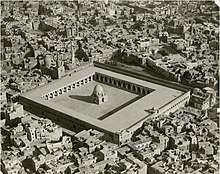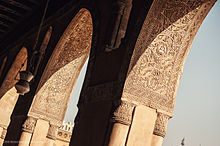The Mosque of Ibn Tulun (Arabic: مسجد إبن طولون, romanized: Masjid Ibn Ṭūlūn) is located in Cairo, Egypt. It is one of the oldest mosques in Egypt as well as the whole of Africa surviving in its full original form, and is the largest mosque in Cairo in terms of land area. It is around an open square courtyard which allows natural light to travel through. Ibn Tulun Mosque features ancient architecture styles of Egypt, its decorations from carved stucco and wood. This mosque is a popular tourist attraction.
Construction history of the Mosque of Ibn Tulun

The mosque was commissioned by the Tulunid dynasty ruler Ahmad ibn Tulun, the Abbasid governor of Egypt from 868–884 whose rule was characterized by de facto independence. It was designed by the prominent Egyptian architect, Saiid Ibn Kateb Al-Farghany (Arabic: سعيد بن كاتب الفرغاني), who was an Orthodox Christian, the same engineer who designed the Nilometer. The historian al-Maqrizi lists the mosque’s construction start date as 876 AD, and the mosque’s original inscription slab identifies the date of completion as AH 265 (878/879).
The mosque was on a small hill ‘Gebel Yashkur’, “The Hill of Thanksgiving.” One local legend says that it is here that Noah’s Ark came to rest after the Deluge, rather than at Mount Ararat. People used the mosque for several purposes. One such purpose is it was a shelter for pilgrims from North Africa to the Hijaz in the 12th century.
The grand congregational mosque intended to be the focal point of Ibn Tulun’s capital, al-Qata’i, which served as the center of administration for the Tulunid dynasty. Originally the mosque backed onto Ibn Tulun’s palace, and a door next to the minbar allowed him direct entry to the mosque. Al-Qata’i was razed in the early 10th century AD. The mosque is the only surviving structure.

Description of the mosque
The Ibn Tulun Mosque, also known as the Mosque of Ibn Tulun, is a stunning example of early Islamic architecture. One of the oldest mosques still standing in the world. Located in the historic district of Darb al-Ahmar in Cairo, Egypt, Ahmad ibn Tulun built the mosque in 879 AD, the founder of the Tulunid dynasty. The mosque was with a unique blend of Roman, Byzantine, and Islamic architectural styles, which gives it a distinctive appearance that sets it apart from other mosques.
One of the most impressive features of the Ibn Tulun Mosque is its size. The mosque’s courtyard can accommodate up to 10,000 worshipers. Making it one of the largest courtyards in any mosque in the world. The courtyard surrounded by a portico with 276 columns, which provides shade for worshippers. The columns are of red granite. Decorated with intricate carvings and capitals that depict plant motifs, animals, and geometric patterns.
The mosque’s interior is just as impressive as its exterior. The walls and ceilings are with intricate geometric and floral patterns, as well as calligraphy in Arabic. The mihrab, or niche that marks the direction of Mecca, is particularly beautiful, with intricate carvings and a marble surround. The minbar, or pulpit, is also with intricate carvings of wood.
Despite its age, the Ibn Tulun Mosque remains an important religious and cultural landmark in Cairo. It is a popular destination for tourists and is one of the most important examples of early Islamic architecture. The mosque is open to visitors and is free to enter. Making it an affordable and accessible way to experience the rich history and culture of Cairo.




Comment (0)